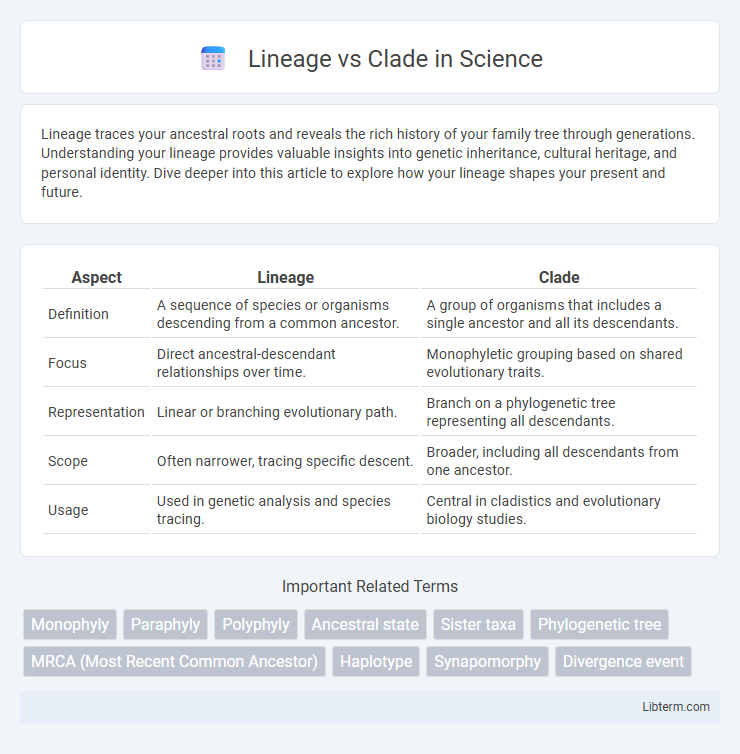Lineage traces your ancestral roots and reveals the rich history of your family tree through generations. Understanding your lineage provides valuable insights into genetic inheritance, cultural heritage, and personal identity. Dive deeper into this article to explore how your lineage shapes your present and future.
Table of Comparison
| Aspect | Lineage | Clade |
|---|---|---|
| Definition | A sequence of species or organisms descending from a common ancestor. | A group of organisms that includes a single ancestor and all its descendants. |
| Focus | Direct ancestral-descendant relationships over time. | Monophyletic grouping based on shared evolutionary traits. |
| Representation | Linear or branching evolutionary path. | Branch on a phylogenetic tree representing all descendants. |
| Scope | Often narrower, tracing specific descent. | Broader, including all descendants from one ancestor. |
| Usage | Used in genetic analysis and species tracing. | Central in cladistics and evolutionary biology studies. |
Understanding Lineage: Definition and Significance
Lineage refers to a direct sequence of species or individuals derived from a common ancestor, highlighting evolutionary relationships over time. Understanding lineage allows researchers to trace genetic inheritance, identify ancestral traits, and map the progression of evolutionary changes across generations. This concept is significant for reconstructing phylogenetic trees and studying species divergence within biological classification.
What Is a Clade? A Comprehensive Overview
A clade represents a group of organisms that includes a common ancestor and all its evolutionary descendants, forming a single branch on the tree of life. This taxonomic concept emphasizes monophyly, where the group shares unique genetic characteristics inherited from their most recent common ancestor. Clades are fundamental in phylogenetic studies and differ from lineages by encompassing entire evolutionary branches rather than just a sequence of ancestors and descendants.
Key Differences Between Lineage and Clade
Lineage refers to a sequence of organisms or cells descended from a common ancestor, traced through direct ancestry, emphasizing temporal evolutionary paths. Clade represents a group of organisms that includes an ancestor and all its descendants, defined by shared derived characteristics and reflecting phylogenetic branching. Unlike lineage, clade focuses on monophyletic grouping within a phylogenetic tree, highlighting evolutionary relationships rather than individual descent chains.
Evolutionary Relationships: Lineage vs Clade Explored
Lineages represent a direct sequence of organisms connected through ancestor-descendant relationships, tracing a single evolutionary path over time. Clades encompass a group of organisms that include a common ancestor and all its descendants, defining a monophyletic group that reflects shared evolutionary history. Understanding evolutionary relationships requires recognizing that lineages highlight temporal ancestry while clades emphasize comprehensive common descent within phylogenetic trees.
Phylogenetic Trees: Visualizing Lineages and Clades
Phylogenetic trees visually represent evolutionary relationships by branching out from common ancestors, highlighting lineages as sequences of descendants through time. Clades are monophyletic groups within these trees, consisting of an ancestor and all its descendants, emphasizing shared evolutionary traits. Lineage tracing follows specific ancestral lines, while clade identification maps broader evolutionary groupings based on genetic divergence.
Genetic Inheritance: How Lineage and Clade Differ
Lineage traces genetic inheritance through a direct ancestral line, focusing on vertical transmission of DNA from one generation to the next, while clade groups organisms based on shared common ancestry identified through phylogenetic analysis. Lineages emphasize stepwise inheritance patterns within a single line, whereas clades encompass all descendants from a common ancestor regardless of branching complexity. This distinction clarifies genetic relationships by differentiating narrow gene flow in lineages from broader evolutionary connections defining clades.
Cladistics vs Lineage Analysis: Methodologies Compared
Cladistics emphasizes the classification of organisms based on shared derived characters to construct clades that represent monophyletic groups, elucidating evolutionary relationships through branching patterns. Lineage analysis traces the direct ancestral-descendant sequences, often using genetic or fossil evidence to map continuous lines of descent without necessarily focusing on shared derived traits. Comparing methodologies, cladistics prioritizes character states and phylogenetic tree construction, while lineage analysis centers on chronological continuity and explicit ancestry tracking.
Real-World Examples of Lineages and Clades
The SARS-CoV-2 virus, responsible for COVID-19, showcases distinct lineages such as B.1.1.7 (Alpha variant), which are genetic branches identified by specific mutations and spreading patterns. Clades, like GISAID's clade GH, group viruses based on broader ancestral relationships, capturing multiple related lineages within a common branch. Real-world monitoring of these lineages and clades enables epidemiologists to track virus evolution, transmission dynamics, and emerging variants with potential public health impacts.
Lineage and Clade in Modern Taxonomy
Lineage and clade are fundamental concepts in modern taxonomy used to classify organisms based on evolutionary relationships. A lineage traces a direct ancestral line from a common ancestor to a particular species or group, highlighting genetic continuity over generations. In contrast, a clade encompasses all organisms that have descended from a single common ancestor, forming a monophyletic group that includes every descendant within that branch of the tree of life.
Future Trends: The Role of Lineage and Clade in Evolutionary Studies
Future trends in evolutionary studies emphasize the integration of lineage and clade analyses to enhance the resolution of phylogenetic relationships and predict evolutionary trajectories. Advances in genomic sequencing technologies enable more precise identification of lineages, while clade-based frameworks facilitate a comprehensive understanding of shared traits and common ancestry. This combined approach supports refined models of species diversification and adaptive evolution, driving deeper insights into the complexity of biological evolution.
Lineage Infographic

 libterm.com
libterm.com